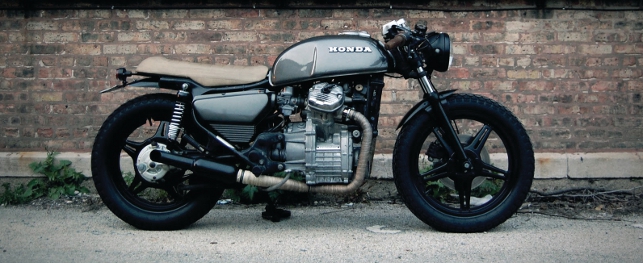Designers and engineers are natural tinkerers. Many have side projects, outside of their day jobs, where they while away their time building and fixing.

After customisation on his 1978 Honda CX500 was complete
One such tinkerer is David Mucci, a professional industrial designer based in Chicago, who has a passion for hand crafted items and custom vintage machinery. Growing up, Mucci always had a project car in the garage that he was working on.
In his final year of studying industrial design at the College for Creative Studies in Detroit, he enrolled on a motorcycle design course. His love of cars soon extended to two-wheeled vehicles. Having worked in design for a few years, Mucci finally had some money to spend on a bike project.
So, in March 2010 he bought a 1978 CX500 Standard. “The bike was fully functioning and came with bins full of spare parts, all for $700. I started out tinkering with general maintenance, but soon stripped it down to the frame and I was sketching up all sorts of concepts,” he says.
Mucci’s design process started out much like he approaches any design project in his day job by roughing out ideas through sketching. “Where my process differed was in the restrictions a motorcycle presented.
In the product design world, you’re usually designing something from scratch instead of modifying an existing object. All the changes you design in will be implemented at the hands of an external manufacturer, using lots of large scale, and very expensive tooling machinery.”
“But, with the bike, I was the manufacturer and my tool supply was much more limited. I found it easier to do a lot of my rough sketching with the bike skeleton in front of me. This allowed me to stay more ‘real’,” describes Mucci.
As he didn’t have a motorcycle design background he didn’t possess all the skills needed and so, there were bound to be a few challenges. “Designing the long, flat trackerstyle seat around the kinked frame of the CX proved to be the most difficult,” he confesses.
“I tried my best to illustrate what I was looking for and with the fabrication help of Tony Prust at Analog Motorcycles, we achieved a solution I’m very happy with. I’m now enrolled in fabrication courses at a local college and plan to implement these skills in the next upcoming build.”
Mucci documented his design and build process on his blog, which the motorcycle press soon caught a whiff of. He has since received a great deal of publicity and was even awarded third place in ‘The 2011 Bike EXIF Top Ten’ list, a list compiled by the popular motorcycle website, Bike EXIF.
However, does Mucci feel intimidated that he’s a novice in the motorcycle customisation world? “The positive side to having minimal knowledge of existing trends and commodities is you’re less likely to fall into a rut,” he explains.
“Project managers in the design world will use this tactic when briefi ng designers on a new project: make the guidelines as brief as possible and you’ll get the broadest range of concepts; implement too many restrictions and you’ll end up restricting the designer’s innovation.
I still see my build as being pretty basic, I just tried to make the most out of what I had and aimed to get it done in three months so I could ride it.
When his CX500 bike was complete, although Mucci took time to enjoy riding it, he was itching to get stuck into a new project. He has since purchased a 1981 Yamaha SR250, which he is in the process of dismantling. “I’ve definitely got the bug,” he smiles. “
“In my off time, I’m working on building a future that involves motorcycles, but for now, I’m concentrating on the next build and will go from there.”
Taking a classic Honda and giving it a beautiful new lease of life
Default








